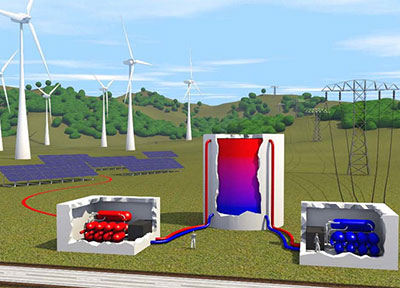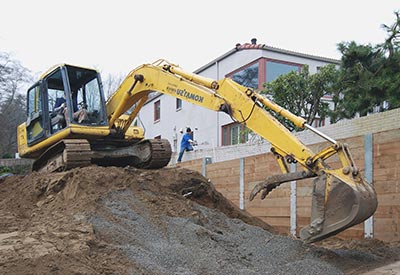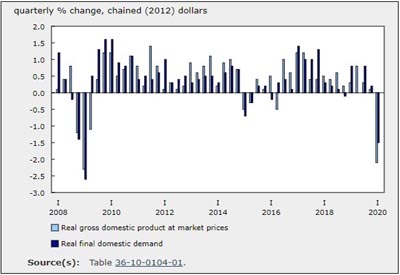Electrical Energy Storage: IEC Report on Present and Future Needs, Part 2

In the near future, electrical energy storage will become indispensable in emerging markets for smart grids and in renewable energy for reducing CO2, says the International Electrotechnical Commission. In a just-published document, the commission summarizes present and future market needs for electrical energy storage technologies, reviews their technological features, and makes recommendations for all electrical energy storage stakeholders. Part 1 reported on the document’s conclusions. Here in Part 2, the recommendations.
Photo: physicsworld.com
http://www.iec.ch/whitepaper/pdf/iecWP-energystorage-LR-en.pdf
Executive summary
Electrical Energy Storage, EES, is one of the key technologies in the areas covered by the IEC. EES techniques have shown unique capabilities in coping with some critical characteristics of electricity, for example hourly variations in demand and price. In the near future EES will become indispensable in emerging IEC-relevant markets in the use of more renewable energy, to achieve CO2 reduction and for Smart Grids.
Historically, EES has played three main roles. First, EES reduces electricity costs by storing electricity obtained at off-peak times when its price is lower, for use at peak times instead of electricity bought then at higher prices. Secondly, in order to improve the reliability of the power supply, EES systems support users when power network failures occur due to natural disasters, for example. Their third role is to maintain and improve power quality, frequency and voltage.
Regarding emerging market needs, in on-grid areas, EES is expected to solve problems — such as excessive power fluctuation and undependable power supply — that are associated with the use of large amounts of renewable energy. In the off- grid domain, electric vehicles with batteries are the most promising technology to replace fossil fuels by electricity from mostly renewable sources.
The Smart Grid has no universally accepted definition, but in general it refers to modernizing the electricity grid. It comprises everything related to the electrical system between any point of electricity production and any point of consumption. Through the addition of Smart Grid technologies the grid becomes more flexible and interactive and can provide real-time feedback. For instance, in a Smart Grid, information regarding the price of electricity and the situation of the power
Conclusions and recommendations
5.1 Drivers, markets, technologies
From the first four sections of the present paper – the substantive, factual, objective part – the present section seeks to derive conclusions in the form of a coherent picture. From these in turn recommendations may be formulated in the areas of policy (including regulation), research & development, and standardization. This is summarized in Figure 5-1.
In the electricity market, global and continuing goals are CO2 reduction and more efficient and reliable electricity supply and use.
Drivers
Renewable energies
Smart Grid
Dispersed generation/Microgrid
Market forecasts
Total EES market
Conventional large-scale Long-term storage
Dispersed storage
Technological and practical implications
Batteries
H2 /SNG (synthetic natural gas)
Lifetime costs
Control / interoperability
Recommendations
a) Policy recommendations
b) R&D recommendations
c) Standards recommendations
Figure 5-1 | Conclusions in the form of a logical progression
Objectives
CO2 reduction
More efficient and reliable electricity
Conclusions and recommendations
The IEC is convinced that electrical energy storage will be indispensable to reaching these public policy goals. It is therefore essential that deployment of storage should receive long- term and robust support from policy-makers and regulators.
Corresponding to these goals, three major drivers determining the future of EES have been identified (see section 3): the foreseeable increase in renewable energy generation, the design and rollout of Smart Grids, and the future spread of dispersed generation and dispersed management of electrical energy – referred to here for simplicity as “microgrids”. These drivers are only partly independent of each other: renewables clearly encourage, and simultaneously need, microgrids, and the increase in both renewables and dispersed sources demands a smarter grid. However, this paper has shown that the three drivers usefully illuminate different aspects of what will condition the future of electrical energy storage systems.
The results of these drivers on future demand for EES may be conveniently divided into four market segments, the total EES market, conventional large- scale systems (e.g. pumped hydro storage, PHS), long-term storage (e.g. H2), and dispersed storage. How these markets are expected to develop has direct implications for which technologies will be most needed, which technology will need what type of further development, what considerations will influence rollout and penetration, and what implementation problems may be expected. A serious analysis of these complex factors, going beyond what has already been attempted in previous sections, is not the purpose here; the four aspects listed, two technology families (batteries and H2/SNG) and two constraints (lifetime costs and control/interoperability), seem merely to be the most important areas for future actions.
This, finally, leads to the actions themselves, i.e. to recommendations. It will be seen below that recommendations fall into groups addressed to three different audiences: policy-makers including regulators, companies and laboratories deciding what research and product development to pursue, and the IEC itself for what standards will be needed by all EES market players.
5.2 Conclusions regarding renewables and future grids
Many studies have shown that EES is indispensable for the introduction of large amounts of renewable energy. Therefore the necessary volume and timing of EES is strongly dependent on the pace of renewable energy development.
The Smart Grid integrates facilities on both the utility (grid) side and the customer side by using advanced information technologies; the benefits from this can only be achieved if storage is available. EES is therefore considered to be a key component of the Smart Grid, among other things as a basic requirement for coping with electrical outages caused by disasters. In addition the Smart Grid is likely to use, and possibly to require, dispersed storage (e.g. batteries installed for local purposes). This in turn implies overall control of many dispersed small storage installations together in the grid9. The implication is that autonomous operation, easy extension and coordination with grids are important characteristics of future EES.
Microgrids will be a key to the “smart” energy use of communities, factories, buildings etc. Small- scale EES is absolutely imperative for microgrids to achieve fair and economic consumption of electrical energy. In order to optimize cost efficiency, microgrids also require that their EES should be connected to the grid (as does the grid – see above) and be able to adjust smoothly to increases and decreases in the amount of electrical energy consumed. Dispersed facilities, whether generation or storage (for example the EES in a smart house or an electric vehicle), are normally owned by end users, who have in principle the right to decide how to use the facilities. This implies a differentiated policy and regulatory regime, with conditions applying to centralized facilities distinguished from those applying to dispersed ones.
5.3 Conclusions regarding markets
The total EES market is expected to be large, but will remain very sensitive to cost (see section 5.4 below). This has very specific implications on what R&D and policy goals are recommended. It also means that whether the relevant standards (e.g. to reduce costs by creating or enlarging homogeneous markets) are available at the right moment will have a great influence.
Some of the total market will be for conventional large-scale EES such as PHS to enable the introduction of renewable energies. The need for extremely large (GWh and TWh-scale) facilities will increase; in some applications they will need to be operated like conventional generators (in spite of being limited in total energy).
When a very high renewable energy ratio is achieved, long-term energy storage will be needed which, since the storage period is up to several months, implies very large storage amounts. A possible solution is the new EES technologies hydrogen and synthetic natural gas (see sections 2.4 and 4.2.2). Development of these involves chemical research and engineering, which are beyond the traditional scope of work of the IEC; this gives rise to certain recommendations.
With rollout of the Smart Grid and microgrids, implying storage installed at customer sites, the market for small and dispersed EES is also expected to be quite large. EES will be used not only for single applications but simultaneously for several, made possible by integrating multiple dispersed storage sites.
5.4 Conclusions regarding technologies and deployment
As the renewable energy (RE) market grows, the market for EES systems, especially for small and dispersed ones, will also expand and require technical specifications and regulation frameworks for grid interconnection of EES. The aspects of interconnecting dispersed generation including RE have been investigated. However, issues such as power quality and safety in connecting large numbers of EES intallations, mostly together with RE, have not yet been thoroughly researched. Thus, in order to assure the smooth connection of EES to grids, additional technical requirements and the necessary regulatory frameworks need to be investigated.
Given the cost sensitivity, cost reduction is vital to implementation. For this, lifetime cost should be considered, not simply installation cost but also cost of operation and disposal. Low raw material cost, a part of total installation cost, may become a specific selection criterion for EES technology. In addition, as explained in sections 3.2 and 3.3, interoperability among the various very different parts of the whole grid must be ensured, and sophisticated control intelligence is also essential for availability and overall efficiency10. Successful deployment in any one country may further depend on the size and health of an indigenous “EES supply industry” which can help to control costs and ensure availability.
Three storage technologies seem to emerge from the study as the most significant. In order of decreasing technological maturity, they are pumped hydroelectricity (PHS), electrochemical batteries, and hydrogen/synthetic natural gas. In Figure 5-1 only the last two are mentioned because they both – in different ways – need more development than PHS. Batteries require development primarily to decrease cost, and for some technologies to increase energy density as well; hydrogen/SNG must be further researched and developed across a broad front, including physical facilities, interactions with existing uses of gas, optimal chemical processes, safety, reliability and efficiency.
5.5 Recommendations addressed to policy-makers and regulators
Recommendation 5.5.1 – Public support for development of conventional storage
Given their intentions to increase greatly the proportion of renewable energies, the IEC recommends policy-makers to consider seriously the further development of conventional storage, such as pumped hydroelectricity, notwithstanding the difficulties of siting and construction.
Recommendation 5.5.2 – Long-term storage, on the order of months
The IEC’s study has shown that many governments’ current plans for how electricity will be generated and managed in the future cannot be implemented without long-term storage with capacities in the multi-TWh range. It therefore recommends policy- makers, whose actions are essential to the creation of long-term, very-large-capacity storage, to work actively on the public aspects, and to create the incentives to encourage private actors to play their part.
Recommendation 5.5.3 – Cooperation between energy sectors; coherent regulations
Hydrogen and synthetic natural gas added to natural gas are likely to be essential elements of future electric grids because of their energy storage duration and capacity. The IEC therefore recommends regulators to achieve the conditions for all necessary cooperation between the energy markets in electricity and gas, including use of infrastructure.
Recommendation 5.5.4 – Incentives for development and operation of storage
The IEC recommends policy-makers to make the encouragement of storage deployment a public policy goal. The long-term storage of surplus energy from renewables is sometimes more expensive than additional generation from existing fossil-fuel plants. However, the storage necessary for future grids will only become available if private actors see an advantage in acquiring and operating it, and for this regulations including financial incentives will frequently be needed. The regulatory regime may also need to differentiate between private consumer-owned storage and storage directly connected to the regulated grid.
Recommendation 5.5.5 – Public policy for and investment in storage research
Several areas are described in the IEC’s study where concentrated research and development are needed. The IEC recommends governments and public authorities with a role in research to adjust their research policies and investments to the desired targets for storage development.
Recommendation 5.5.6 – Potential barriers to the introduction of microgrids
Some existing regulatory regimes hinder the introduction or operation of microgrids or their storage components. The IEC recommends these to be revised, since microgrids will be essential to future electricity distribution and should be encouraged.
Recommendation 5.5.7 – Regulations for the safety of new storage technologies
The IEC expects to keep pace, as in other areas in the past, with the need for international consensus standards for the safety of new storage technologies. It recommends regulators to anticipate the requirement to guarantee this safety, and to contribute to shaping suitable International Standards upon which harmonized regulations may be based.
Recommendation 5.5.8 – Environmental regulations for new storage technologies
New storage technologies may present new challenges in protecting the natural and human environment, challenges involving the materials, conditions and land use required to implement them. The IEC recommends regulators to help ensure that standards are in place to allow an internationally agreed technical basis for any new regulations, so that unnecessary differences among countries and regions may be avoided.
5.6 Recommendations addressed to research institutions and companies carrying out R&D
Recommendation 5.6.1 – R&D targeted to low-cost materials and manufacturing
The IEC recommends targeting research and development to EES technologies with a potential for low raw-material cost and low-cost mass production techniques.
Recommendation 5.6.2 – Research on renewables’ interactions with storage
Since the specifications and volume of the storage needed are largely influenced by renewable energies, the IEC recommends further study of the influence of renewable energies on the power system and the functions that storage should fulfil in consequence.
Recommendation 5.6.3 – R&D on hydrogen and synthetic natural gas used for EES
Storage and use of hydrogen, and generation and use of synthetic natural gas for storing electricity,
are relatively new technologies; improvements particularly in reliability and cost are needed. In addition, in order to use existing gas supply and distribution networks, technical and procurement issues will arise in infrastructure, system operation and safety. The IEC recommends the electric power sector, the gas sector and research laboratories to pursue collaborative research and development in these areas.
Recommendation 5.6.4 – Development of versatile storage management systems
The IEC recommends industry to develop storage management systems which will allow use of a single storage system for not just one but many of the applications described in the IEC study. Controllers and management systems are required which function independently of the types of the batteries being controlled11. Also, the control technology should function even when the applications belong to different actors (grid operator, end-use supplier, consumer).
Recommendation 5.6.5 – Development of local storage for grid use
The IEC recommends industry and utilities to develop the technology to use storage rationally and efficiently for both local purposes and grid purposes 12, allowing many dispersed storage installations to be used as a single, large facility.
Recommendation 5.6.6 – Development of vehicle-to-grid and vehicle-to-home
Since electric vehicle batteries are a potential source of storage for grid regulation and electricity use outside the vehicle, the IEC recommends research and development of vehicle-to-grid and vehicle-to-home technologies.
Recommendation 5.6.7 – Architecture
A precondition to many of the standards recommended in the IEC study is a robust architecture and management/control scheme for storage, which today is not available. The IEC recommends laboratories and industry to collaborate with the IEC to develop rapidly an architecture and management scheme, to serve as the basis for standards.
5.7 Recommendations addressed to the IEC and its committees
Recommendation 5.7.1 – Cooperation needed for hydrogen and SNG standards
The MSB recommends the IEC to work out future standardization solutions in the domain of hydrogen and synthetic natural gas (SNG) storage in close collaboration with ISO and with industries, such as hydrogen, natural gas and petroleum, with which it has historically had few contacts.
Recommendation 5.7.2 – Architecture and structure of EES systems
The IEC study shows that a thorough, shared com- prehension of the roles and functions of storage in all grid-related circumstances is currently not available. The MSB therefore recommends the IEC to develop an EES architecture and a funda- mental standard on the structure of EES systems, upon which all the other standards needed may be based.
Recommendation 5.7.3 – Users’ guide on planning and installing storage
One of the determining factors in successful rollout of storage solutions will be the players’ level of understanding of the cost and functionality of the different technologies. The MSB recommends the IEC to develop a users’ guide containing suggested criteria to apply when planning and
using each specific technology (type of product) for a specific application. In addition to data on storage technology behaviour and characteristics (speed, power, energy), it will probably also need to contain information on full lifecycle cost, disposal cost, regulatory considerations, and environmental advantages and disadvantages.
Recommendation 5.7.4 – Interface, control and data element standards
Several elements of the IEC study show a pressing need for the control and interconnection of EES installations: small-scale storage in microgrids and its connection to the grid, integration of storage systems with different technologies into a single virtual store, systems used jointly by different organizations (generation plant owner, grid operator, electricity seller) and for different applications, etc. Insofar as the relevant standards do not yet exist, the MSB therefore recommends the IEC to standardize rapidly the interfaces between storage and other grid elements, protocols for data exchange and control rules, and the data elements for the input, output and control information supplied by or to storage systems.
Recommendation 5.7.5 – Standards for systems to relieve transmission congestion
The introduction of large quantities of renewable energies will cause transmission system conges- tion, to which storage can be a solution. Some of the resulting integrated systems, for example a hy- brid system consisting of storage combined with a wind farm, will require standards in order to func- tion correctly. The MSB recommends the SMB to initiate the standards needed.
Recommendation 5.7.6 – Standards for unit size and other factors affecting costs
Reducing lifetime costs of storage requires, among many other things, a range of standards, such as standardized EES unit sizes and technical features to allow mass production of associated equipment. The MSB therefore recommends the SMB to launch such projects.
Recommendation 5.7.7 – Safety of new storage technologies
The rapid growth and the new technologies involved in electrical energy storage in the near future, as well as their installation by consumers, will impose particular requirements for safety. At the same time, society and governments will need assurance of safety before the much-needed systems can be deployed. The MSB therefore recommends the SMB to set in motion rapidly the development of storage safety standards.
Recommendation 5.7.8 – Compatibility of EES with the environment
The scale, the impact and the materials of EES all represent potential challenges to the environment, especially when new technologies are involved. Without International Standards in place the regulatory requirements may be different in different regions, which would be an unnecessary burden on manufacturers and owners. The MSB consequently recommends that standards for EES compatible with the environment be developed as soon as possible.
9. A single virtual energy storage installation.
10. These aspects of implementation will be particularly dependent on the existence of the relevant international standards.
11. See also Rec. 5.7.4 which mentions standardization of control for batteries with different technologies.
12. E.g. “Battery SCADA” – see section 3.3.4.
Read the entire document: www.iec.ch/whitepaper/pdf/iecWP-energystorage-LR-en.pdf.
Read Part 1 – 3 Ways Energy Innovation Will Heat Up in 2016.











